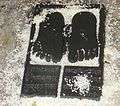Aranatha
| Aranatha | |
|---|---|
| 18th Jain Tirthankara, 7th Chakravartin, 13th Kamadeva | |
 Images of Tirthankara (Gwalior Fort) | |
| Symbol | Fish (as per Digambar Sect) Nandavarta (as per Swetember Sect) |
| Height | 30 bows (90 metres) |
| Age | over 84,000 years |
| Color | Golden |
| Parents |
|
| Preceded by | Kunthunatha |
| Succeeded by | Māllīnātha |
| Born | Hastinapur |
| Moksha | Shikharji |
| Part of a series on |
| Jainism |
|---|
 |
|
Jain prayers |
|
Ethics |
|
Major figures |
|
Major sects |
|
Festivals |
|
Pilgrimages |
|
|
Aranath was the eighteenth Jain Tirthankar of the present half cycle of time (Avasarpini).[1] He was also the seventh Chakravartin[2] and thirteenth Kamadeva. According to Jain beliefs, he was born around 16,585,000 BCE. He became a siddha i.e. a liberated soul which has destroyed all of its karmas. Aranath was born to King Sudarshan and Queen Devi (Mitra) at Hastinapur in the Ikshvaku dynasty.[1] His birth date was the tenth day of the Migsar Krishna month of the Indian calendar.
Life
Like all other Chakravartin, he also conquered all the lands[2] and went to write his name on the foothills of mountains. Seeing the names of other Chakravartin already there, he saw his ambitions dwarfed. He then renounced his throne and became an ascetic for penance.[2] At an age over 84,000 years he and attained Moksha (liberation) on Mount Shikharji.[2]
Worship
Svayambhūstotra by Acarya Samantabhadra is the adoration of twenty-four tirthankaras. Twenty slokas (aphorisms) of Svayambhūstotra are dedicated to Tirthankar Aranath.[3] One such sloka is:
O Passionless Lord Aranatha! Your physical form which is free from all vestiges of ornaments, clothes and weapons, and the embodiment of unalloyed knowledge, control of the senses, and benevolence, is a clear indication that you have vanquished all blemishes.— Svayambhustotra (18-2-12)[4]
Temples
- Chaturmukha Basadi is a famous Jain temple located at Karkala in the Indian state of Karnataka. The temple is dedicated to Tirthankara Aranatha, Mallinath and Munisuvratnath.[5]
- Prachin Bada Mandir, Hastinapur, Uttar Pradesh
-
Chaturmukha basadi (Karnataka) dedicated to Tirthankara Aranath
-

Jain temple dedicated to Tirthankar Aranath
-

Prachin Bada Mandir,Hastinapur
-

Footprints at Aranath Tonk, Shikhar Ji
See also
| Wikimedia Commons has media related to Aranatha. |
References
- 1 2 Tukol 1980, p. 31.
- 1 2 3 4 von Glasenapp 1999, p. 308.
- ↑ Vijay K. Jain 2015, p. 118-129.
- ↑ Vijay K. Jain 2015, p. 122.
- ↑ Sandhya, C D’Souza (19 November 2010), "Chaturmukha Basadi: Four doors to divinity Last updated", Deccan Herald
Sources
- Jain, Vijay K. (2015), Acarya Samantabhadra's Svayambhustotra: Adoration of The Twenty-four Tirthankara, Vikalp Printers, ISBN 978-81-903639-7-6,
 This article incorporates text from this source, which is in the public domain.
This article incorporates text from this source, which is in the public domain. - Tukol, T. K. (1980), Compendium of Jainism, Dharwad: University of Karnataka
- von Glasenapp, Helmuth (1999), Jainism: An Indian Religion of Salvation [Der Jainismus: Eine Indische Erlosungsreligion], Shridhar B. Shrotri (trans.), Delhi: Motilal Banarsidass, ISBN 81-208-1376-6